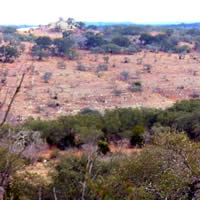Flint Knob
Flint Knob (41TV1463) in western Travis County was a source for flint for prehistoric peoples over thousands of years. Flint (technically chert) was the most commonly used stone for making tools in Texas. In the archeological literature, such sites are usually called lithic procurement sites or, less accurately as quarry sites.
At Flint Knob, the hilltop, or knob, is a thin remnant of the chert-bearing Edwards geological formation that has resisted weathering and erosion. Visible on the surface are exposures of brownish to purplish, tabular chert, much of it covered with a white, weathered layer or rind known as cortex.
Here ancient flint knappers came to dig or pry out or simply collect from the surface large pieces of Edwards chert. They checked the quality of the material by knocking off a few flakes, leaving behind discarded tested cobbles that didn’t pass muster. The intent of most workers at this site, and many other lithic procurement sites, was to acquire raw chert material and reduce it to a manageable size so that it could be carried to another location for the actual toolmaking.
Some knappers reduced cobbles by flaking off the entire surface layer (cortex) and shaping the piece into a flat biface (chipped on both sides/faces) often called a quarry blank. Most quarry blanks were presumably hauled off for final work elsewhere. There is, however, evidence at Flint Knob that some knappers stayed around long enough to reduce chert pieces into smaller and thinner bifaces destined for use as knives or dart points. Flint Knob has yielded some thin bifaces broken during the reduction process or rejected because of impurities or flaws in the chert.
Chert from Flint Knob (and nearby Chalk Knob) produces a distinctive pumpkin color when exposed to fluorescent light. Most of the artifacts recovered over a 7,000-acre survey of the surrounding area showed similar pumpkin coloration. Although the use of fluorescent light to source chert material is not an exact science, the technique indicates that Flint Knob provided most of the raw stone material for flintknappers in this local area of the Edwards Plateau, from Paleoindian to Late Prehistoric times.




